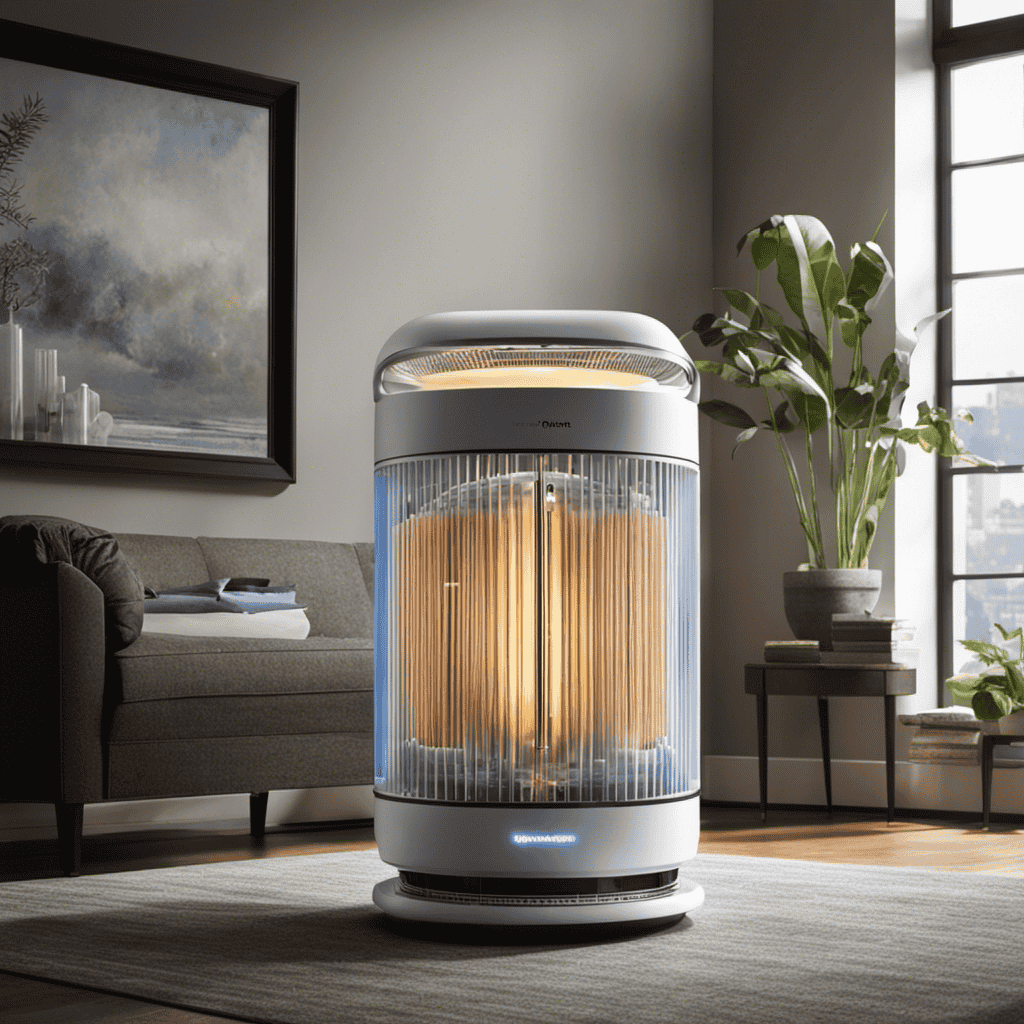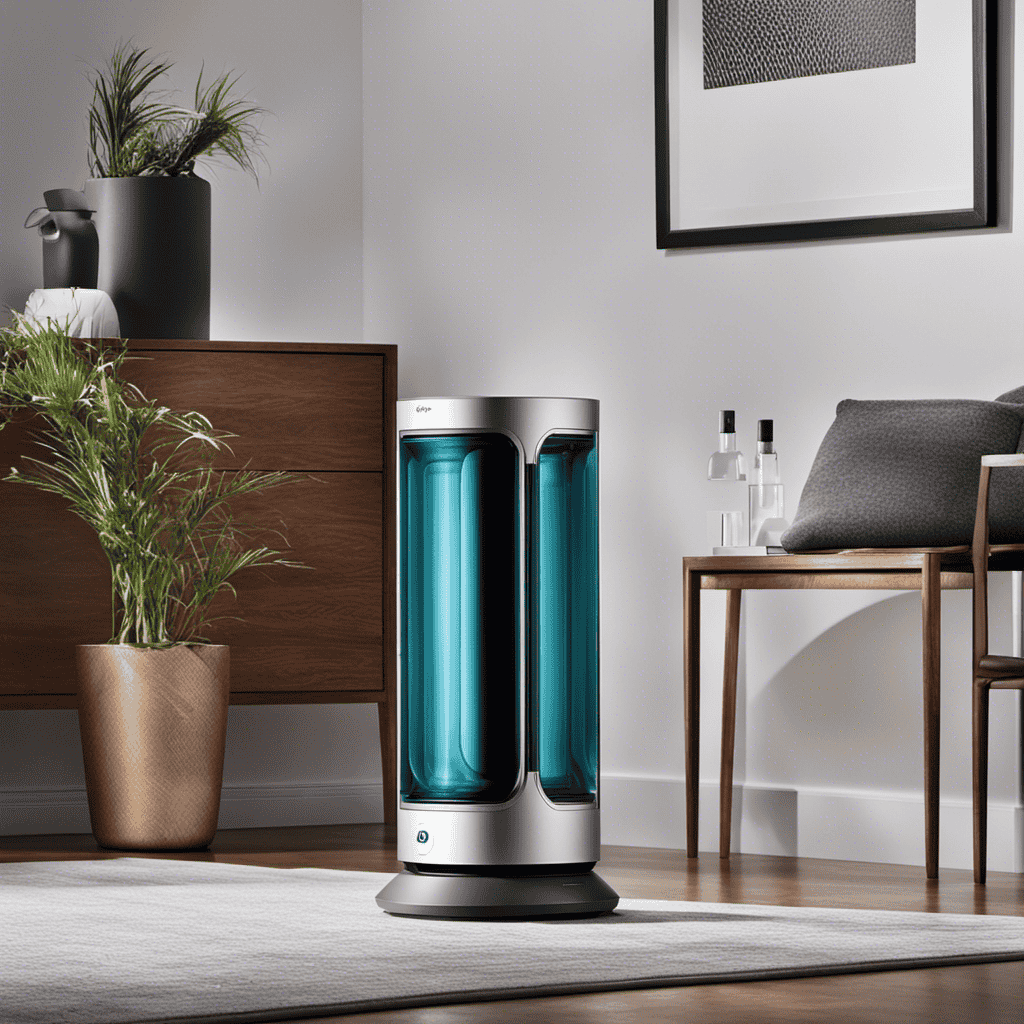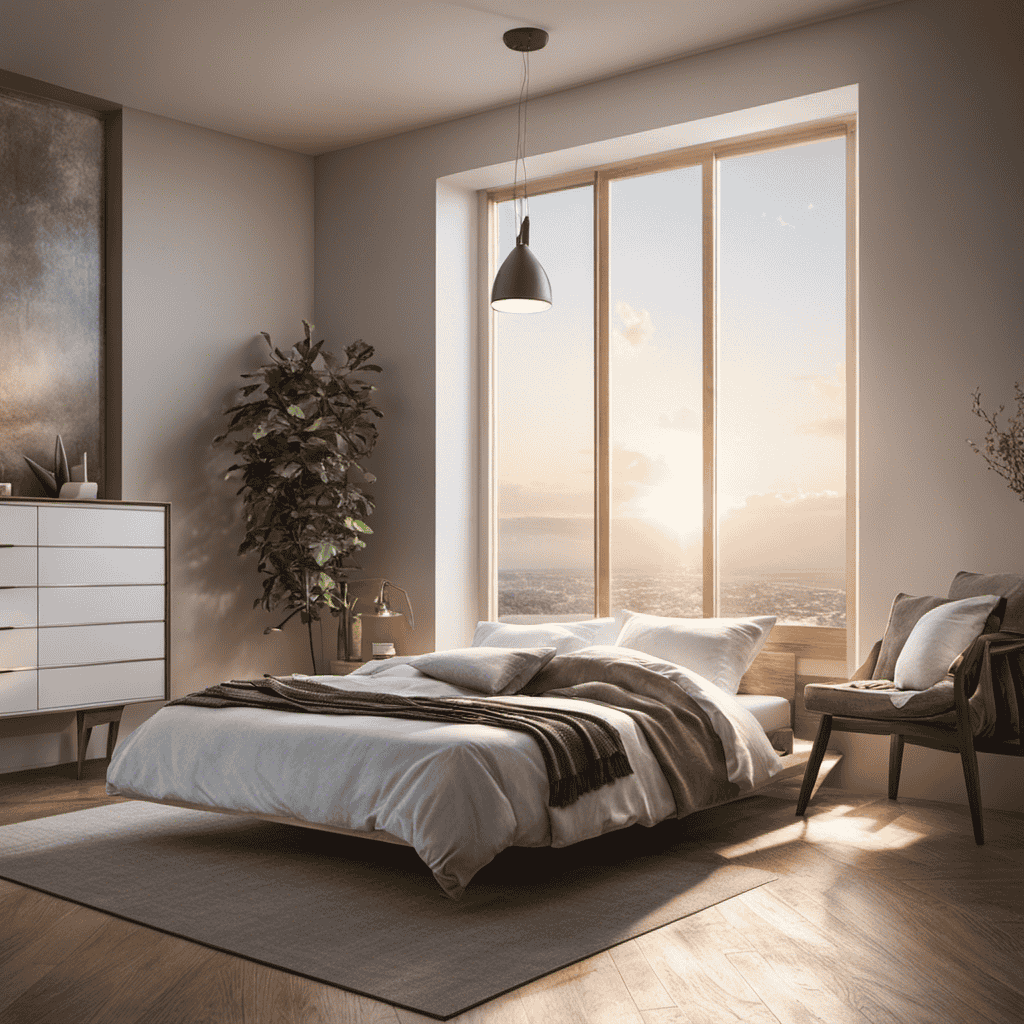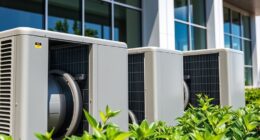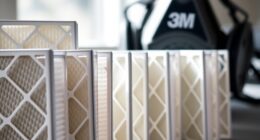I have always been curious about the functionality of ionic air purifiers and how they are able to efficiently eliminate pollutants from the air. Being someone who appreciates clean and fresh air, this subject has sparked my interest.
In this article, we will delve into the basics of ionic technology and explore how these purifiers combat odors and mold spores.
Additionally, we’ll discuss the noise level of these devices and provide maintenance tips to ensure optimal performance.
So, let’s dive in and uncover the secrets behind the workings of ionic air purifiers.
Key Takeaways
- Ionic air purifiers release negative ions into the air, which attach themselves to harmful particles like dust, pollen, and smoke.
- The attached particles become too heavy to remain in the air and fall to the ground or surfaces, effectively removing pollutants from the air.
- Negative ions can also neutralize odors and improve respiratory health.
- Ionizing air purifiers use electrostatic charge to capture pollutants, drawing them to positively charged plates or filters inside the device, thus improving indoor air quality.
The Basics of Ionic Air Purifiers
So, you’re probably wondering how an ionic air purifier actually works, right? Well, let me break it down for you.
The key to understanding the ionization process is negative ions. These are charged particles that are produced by the air purifier and released into the air.
As these negative ions disperse, they attach themselves to harmful particles like dust, pollen, and smoke, making them too heavy to remain in the air. This causes the particles to fall to the ground or onto surfaces, effectively removing them from the air you breathe.
The benefits of using negative ions in air purification are numerous. Not only do they remove harmful particles, but they can also help to neutralize odors, boost mood, and improve overall respiratory health.
Understanding Ionic Technology
To understand how it operates, you can think of ionic technology as a way to purify the air around you. Ionic air purifiers work by emitting negative ions into the air. These negative ions attach themselves to harmful particles such as dust, pollen, and smoke, causing them to become heavier and fall to the ground. This process effectively removes these pollutants from the air, resulting in improved air quality.
Understanding negative ions:
- Negative ions are molecules that have gained an additional electron, giving them a negative charge.
- They are naturally found in environments such as waterfalls, forests, and beaches.
- Negative ions have been shown to have a positive impact on mood, energy levels, and overall well-being.
The impact of ions on air quality:
- Negative ions help to neutralize and remove pollutants from the air.
- They can reduce airborne bacteria and viruses.
- The presence of negative ions can improve respiratory health and reduce allergy symptoms.
How Ionic Air Purifiers Remove Pollutants
When it comes to removing pollutants from the air, ionizing air molecules is a key mechanism used by ionic air purifiers. These devices release negative ions into the air, which attach themselves to air molecules, creating negative charges.
These charged air molecules then attract and attach to positively charged airborne particles, such as dust, pollen, and smoke, effectively removing them from the air and improving indoor air quality.
This process is highly effective in removing harmful contaminants and allergens from the air, making ionizing air purifiers a popular choice for those looking to improve the air they breathe.
Ionizing Air Molecules
Have you ever wondered how ionizing air molecules can improve the air quality in your home? When it comes to ionizing air pollutants, there are several ways in which it benefits our health. Here are three key points to consider:
-
Ionizing air molecules work by releasing negative ions into the air, which attach themselves to positively charged particles such as dust, allergens, and pollutants. This process effectively neutralizes these harmful substances and makes them heavier, causing them to fall to the ground or stick to surfaces, thus reducing their presence in the air we breathe.
-
By removing these air pollutants, ionizing air molecules can significantly improve indoor air quality, reducing the risk of respiratory issues, allergies, and other health problems associated with poor air quality.
-
Additionally, the negative ions released by ionizers have been found to have a positive impact on our overall well-being. Studies have shown that negative ions can increase serotonin levels, which can help improve mood, reduce stress, and enhance overall mental health.
Attracting Airborne Particles
Attracting airborne particles, ionizing air molecules release negative ions that attach themselves to positively charged particles. This process helps to capture and remove pollutants from the air, making it cleaner and healthier to breathe. Ionic air purifiers use an electrostatic charge to attract and trap these particles, including common allergens like pollen and dust. By emitting negative ions, the air purifier creates an environment where these particles are drawn to the positively charged plates or filters inside the device. This method of capturing pollutants is highly effective and has been scientifically proven to improve indoor air quality. With an ionic air purifier, you can enjoy cleaner air and reduce your exposure to allergens and irritants.
| Pollutant | Captured by Ionic Air Purifier |
|---|---|
| Pollen | Yes |
| Dust | Yes |
| Pet Dander | Yes |
| Mold Spores | Yes |
Removing Harmful Contaminants
Removing harmful contaminants, such as pollen, dust, pet dander, and mold spores, is crucial for improving indoor air quality. One effective method of achieving this is by using an ionic air purifier.
These devices work by emitting negative ions into the air, which attach to positively charged particles like pollutants and allergens. The attached ions become heavy and are then drawn towards positively charged surfaces, such as walls or filters, effectively removing them from the air.
The process of ionization also helps to neutralize odors and kill bacteria and viruses. Ionic air purifiers are known for their efficiency in removing pollutants and improving air quality, making them a popular choice for individuals with respiratory conditions or allergies.
The Role of Negative Ions in Air Purification
When it comes to air purification, negative ions play a crucial role in effectively removing pollutants from the air. These ions, which carry a negative electrical charge, attach to airborne particles and cause them to become heavy and fall out of the air.
The benefits of negative ions in air purification include improved indoor air quality, reduced allergens, and a cleaner and fresher environment.
Negative Ions and Purification
To understand how an ionic air purifier works, you’ll want to know how negative ions play a role in the purification process. Negative ions are molecules that have gained an extra electron, giving them a negative charge. These ions are generated by the air purifier and released into the air. They attach themselves to harmful particles, such as dust, pollen, and bacteria, causing them to become too heavy to remain airborne. As a result, these particles fall to the ground or onto surfaces, effectively removing them from the air you breathe.
Negative ions have been found to have various benefits for mental health. Studies have shown that they can help reduce symptoms of depression and anxiety, improve mood, and enhance overall well-being. Additionally, negative ions have been found to have a positive impact on sleep quality. They can promote relaxation, reduce stress, and improve the overall sleep experience.
Benefits of Negative Ions
If you’re looking to improve your mental health and sleep quality, negative ions can have numerous benefits. Negative ions are molecules that have gained an extra electron, and they are found abundantly in nature, especially near waterfalls, mountains, and forests. These ions have been shown to have a positive impact on our well-being.
Research suggests that exposure to negative ions can help reduce symptoms of depression and anxiety by increasing serotonin levels in the brain. Serotonin is a neurotransmitter that regulates mood, and low levels of it have been linked to mental health disorders. Negative ions can also promote better sleep by improving the overall quality and duration of rest. They have a calming effect on the nervous system, making it easier to fall asleep and stay asleep throughout the night.
Here is a table highlighting some of the benefits of negative ions on mental health and sleep quality:
| Positive Effects on Mental Health | Positive Effects on Sleep Quality |
|---|---|
| Reduces symptoms of depression | Improves sleep duration |
| Alleviates anxiety | Enhances sleep quality |
| Boosts mood | Promotes relaxation |
| Increases serotonin levels | Reduces sleep disturbances |
| Enhances overall well-being | Calms the nervous system |
Benefits of Using an Ionic Air Purifier
One of the benefits of using an ionic air purifier is that it can help remove airborne particles such as dust and pollen. Negative ions produced by the purifier attach themselves to these particles, causing them to become heavy and fall to the ground. This process effectively reduces the concentration of pollutants in the air, improving the overall air quality.
Some additional benefits of using an ionic air purifier include:
- Reduction of bacteria and viruses in the air, leading to a healthier environment
- Neutralization of odors by breaking down and eliminating odor-causing molecules
- Improvement of respiratory conditions such as asthma and allergies by reducing irritants in the air
Factors to Consider When Choosing an Ionic Air Purifier
When deciding on an ionic air purifier, it is important to consider the effectiveness of its purification techniques and the long-term maintenance costs.
Effective purification techniques ensure that the air in your space is thoroughly cleaned, removing harmful particles and improving overall air quality.
Additionally, considering long-term maintenance costs is crucial as it allows you to assess the financial commitment required to keep the purifier running efficiently over time.
Effective Purification Techniques
The ionic air purifier uses an electrostatic charge to effectively remove airborne particles. This technology has several benefits over traditional air purifiers:
-
Improved Air Quality:
-
The electrostatic charge attracts and captures particles as small as 0.1 microns, such as dust, pollen, and pet dander.
-
The process helps reduce allergens and irritants, improving indoor air quality.
-
Energy Efficiency:
-
Ionic air purifiers consume less energy compared to traditional filter-based purifiers.
-
They don’t require frequent filter replacements, saving money in the long run.
-
Silent Operation:
-
Ionic air purifiers operate silently, making them ideal for bedrooms and offices.
-
Unlike traditional purifiers, they don’t use fans to circulate air, reducing noise pollution.
Long-Term Maintenance Costs?
To minimize long-term maintenance costs, you’ll want to consider the frequency of filter replacements and the associated expenses.
When it comes to air purifiers, one important factor to consider is their long-term durability. Investing in a durable air purifier can save you money in the long run. Look for models that are made with high-quality materials and have a reputation for lasting a long time.
Additionally, consider the cost effectiveness of the filters. Some air purifiers require expensive replacement filters that need to be changed frequently, which can add up over time. Look for models that have affordable replacement filters or even reusable filters that can be cleaned and reused.
The Difference Between Ionic and HEPA Air Purifiers
If you’re looking to understand the difference between ionic and HEPA air purifiers, you’ll find that the former uses charged ions while the latter relies on a physical filter.
Ionic air purifiers work by emitting negatively charged ions into the air, which attach to airborne particles and make them heavier, causing them to fall to the ground or stick to surfaces.
On the other hand, HEPA air purifiers use a physical filter made of fine mesh to capture and trap particles as small as 0.3 microns.
Here are the advantages of HEPA filters over ionic air purifiers:
- HEPA filters are more effective at removing particles from the air, including dust, pollen, pet dander, and mold spores.
- HEPA filters do not produce any harmful byproducts, unlike ionic air purifiers which can generate trace amounts of ozone.
- HEPA filters have a longer lifespan and can be easily replaced, making them more cost-effective in the long run.
Common Misconceptions About Ionic Air Purifiers
When comparing ionic air purifiers to other types, it is essential to consider the differences in ozone production. Ionic air purifiers use electrically charged ions to remove pollutants from the air. However, they can also produce ozone as a byproduct, which can be harmful in high concentrations.
Additionally, the effectiveness of ionic air purifiers may vary when compared to other types such as HEPA filters or activated carbon filters. This is because they rely on different mechanisms to trap and remove pollutants.
Ionic Vs. Ozone Production
Ionic air purifiers produce negative ions, which can have a similar effect to ozone production. However, it is important to note that not all ionic air purifiers produce ozone. In fact, many models are specifically designed to be ozone-free, addressing the health concerns associated with ozone exposure. Here are some key points to consider:
-
Ozone-free purification:
-
Ionic air purifiers use electrostatically charged plates or needles to generate negative ions.
-
These ions attach to airborne particles, making them heavier and causing them to fall or be easily captured by filters.
-
This process helps to remove pollutants, allergens, and other harmful substances from the air without producing ozone.
-
Health concerns:
-
Ozone can be harmful when inhaled in high concentrations.
-
Some individuals may be more sensitive to ozone exposure, experiencing respiratory irritation or exacerbation of existing conditions.
-
Ozone-free purification methods provide a safer alternative for those concerned about potential health risks.
Effectiveness Vs. Other Types
One major factor to consider when comparing the effectiveness of ionic air purifiers with other types is the size of the space that needs to be purified. Ionic air purifiers are known for their ability to remove particles as small as 0.01 microns, much smaller than what HEPA filters can capture. However, their effectiveness may vary depending on the size of the room.
In a comparison of effectiveness between ionic air purifiers and HEPA filters, it is important to note that both have their strengths and weaknesses. While ionic air purifiers excel at removing smaller particles, HEPA filters are more efficient at trapping larger particles.
Additionally, when comparing ionic air purifiers with activated carbon filters, it is essential to consider the type of pollutants present in the air. Ionic air purifiers are effective at removing airborne particles, but they may not be as effective at removing gases, odors, and volatile organic compounds (VOCs) as activated carbon filters.
Table: Comparison of Ionic Air Purifiers with Other Types
| Ionic Air Purifiers | HEPA Filters | Activated Carbon Filters | |
|---|---|---|---|
| Particle | Effective at | Efficient at | Not as effective at |
| Removal | removing small | trapping | removing gases, |
| particles | larger particles | odors, VOCs | |
| (0.01 microns) |
How Ionic Air Purifiers Improve Indoor Air Quality
Using an ionic air purifier can help improve the quality of indoor air. These devices work by emitting negative ions into the air, which attach to positively charged particles like dust, pollen, and pet dander, causing them to become too heavy to remain airborne. The particles then settle on surfaces, making it easier to clean them.
Ionic air purifiers also have the added benefit of improving air circulation by generating a small breeze that helps distribute the purified air throughout the room. This can be particularly beneficial in spaces with poor ventilation.
The Science Behind Ionic Air Purification
To understand how ionic air purification improves indoor air quality, you need to grasp the science behind it.
Ionic air purifiers work by emitting negative ions into the air, which attach to positively charged particles such as dust, pollen, and smoke. These particles become heavier and fall out of the air, effectively reducing air pollution.
Additionally, the negative ions produced by the purifier can neutralize harmful positive ions in the air. Positive ions are often found in high concentrations in polluted environments and can have adverse effects on respiratory health.
By reducing the levels of positive ions and removing pollutants from the air, ionic air purifiers can help improve respiratory health and reduce symptoms such as coughing and wheezing.
Studies have shown that using ionic air purifiers can lead to a significant decrease in indoor air pollution and improve overall air quality.
The Effectiveness of Ionic Air Purifiers on Allergens
If you’re looking for an effective way to reduce allergens in your indoor environment, consider the benefits of using an ionic air purifier.
Ionic air purifiers have been shown to be particularly effective in removing pet dander, which is a common allergen for many people. Research has found that these purifiers can significantly reduce the levels of pet dander in the air, leading to improved respiratory health for individuals with allergies or asthma.
The negative ions released by the purifier attach to the positively charged pet dander particles, causing them to become heavy and fall out of the air. This helps to prevent them from being inhaled and triggering allergic reactions. By reducing pet dander, ionic air purifiers can have a positive impact on respiratory health.
In the next section, we will explore how these purifiers combat odors.
How Ionic Air Purifiers Combat Odors
In the previous subtopic, we discussed the effectiveness of ionic air purifiers on allergens, particularly pet dander. Now, let’s explore how these devices combat odors, including the impact on cigarette smoke.
Ionic air purifiers work by emitting negative ions into the air. These ions attach to positively charged particles like smoke and odors, causing them to become too heavy to remain airborne. As a result, they settle onto surfaces, making the air cleaner and fresher.
When it comes to cigarette smoke, ionic air purifiers can be effective in reducing its presence. The negative ions released by the purifier attach to the smoke particles, causing them to fall out of the air. However, it’s important to note that while ionic air purifiers can help improve air quality, they may not completely eliminate the smell or harmful substances associated with smoking.
Now, let’s move on to the next subtopic: the impact of ionic air purifiers on mold spores.
Ionic Air Purifiers and Mold Spores
Moving on to mold spores, it’s important to understand how ionic air purifiers can help combat their presence. Ionic air purifiers work by releasing negatively charged ions into the air. These ions attach themselves to airborne particles, including mold spores, making them too heavy to remain airborne. As a result, the mold spores become trapped in the air purifier’s collection plates or fall to the ground, preventing them from spreading throughout the room.
Here are three key ways in which ionic air purifiers contribute to mold prevention and provide health benefits:
-
Elimination of Mold Spores: Ionic air purifiers effectively remove mold spores from the air, reducing the risk of respiratory issues and allergies.
-
Improved Air Quality: By removing mold spores, ionic air purifiers help improve indoor air quality, creating a healthier living environment.
-
Odor Control: Mold often produces a musty odor. Ionic air purifiers can help eliminate this odor by capturing mold spores and other particles responsible for the unpleasant smell.
The Noise Level of Ionic Air Purifiers
Now let’s talk about the noise level of ionic air purifiers. One of the benefits of these devices is their silent operation. Unlike traditional air purifiers that use fans, ionic air purifiers don’t rely on moving parts to clean the air. Instead, they use ionization technology to remove pollutants. This means they operate with minimal noise, making them perfect for use in bedrooms, offices, or any other quiet spaces.
The silent operation of ionic air purifiers is achieved through noise reduction techniques. These devices are designed to minimize vibrations and eliminate the need for loud fans. As a result, they produce little to no noise while effectively improving air quality.
If you’re looking for an air purifier that won’t disturb your peace and quiet, consider choosing an ionic air purifier with its silent operation and noise reduction capabilities.
Maintenance and Cleaning Tips for Ionic Air Purifiers
Regular maintenance and cleaning are essential for keeping your ionic air purifier functioning effectively and efficiently. Here are some maintenance tips and cleaning techniques to ensure the longevity and optimal performance of your device:
-
Replace the filters regularly: The filters in your air purifier trap pollutants and need to be replaced at least every 3-6 months, depending on usage.
-
Clean the exterior: Wipe the exterior of the air purifier with a soft cloth to remove dust and dirt.
-
Clean the ionization wires: Use a soft brush or cloth to gently clean the ionization wires, as they can accumulate dust and affect the device’s performance.
Frequently Asked Questions
Can Ionic Air Purifiers Effectively Remove Mold Spores From Indoor Air?
Yes, ionic air purifiers effectively remove mold spores from indoor air. They use negatively charged ions to attract and neutralize airborne particles, improving indoor air quality and providing numerous benefits for users.
Do Ionic Air Purifiers Produce Any Noise While Operating?
Do ionic air purifiers produce any noise while operating? The silent operation of these devices ensures a peaceful environment. Their noise level is minimal, allowing you to enjoy the benefits of clean air without any disturbances.
How Often Should I Clean and Maintain My Ionic Air Purifier?
I clean and maintain my ionic air purifier regularly to ensure its optimal performance. Cleaning frequency varies depending on usage and manufacturer’s recommendations. Here are some maintenance tips to keep it in good condition.
Can Ionic Air Purifiers Eliminate Odors Caused by Pets or Cooking?
Yes, ionic air purifiers can eliminate odors caused by pets or cooking. They work by emitting negatively charged ions that attach to positively charged particles, such as odors, and remove them from the air.
Are There Any Potential Health Risks Associated With Using Ionic Air Purifiers?
There may be potential side effects associated with using ionic air purifiers. Long term health effects are still being studied, but it’s important to consider factors like ozone emission and individual sensitivities.
Does the Ion Setting on an Air Purifier Affect How Well It Works?
Yes, the ion setting on air purifier can affect how well it works. When activated, the ion setting releases negatively charged ions that can attach to airborne particles, making them too heavy to remain in the air. This can improve the overall effectiveness of the air purifier in removing pollutants.
Conclusion
In conclusion, I’ve learned that ionic air purifiers are powerful tools for removing pollutants from the air we breathe. They utilize negative ions to attract and neutralize harmful particles, making our indoor environment cleaner and healthier. These purifiers are also effective in combating odors and mold spores. However, it’s important to note that regular maintenance and cleaning are crucial for optimal performance. With all these benefits, using an ionic air purifier is like having a breath of fresh air in your home.
